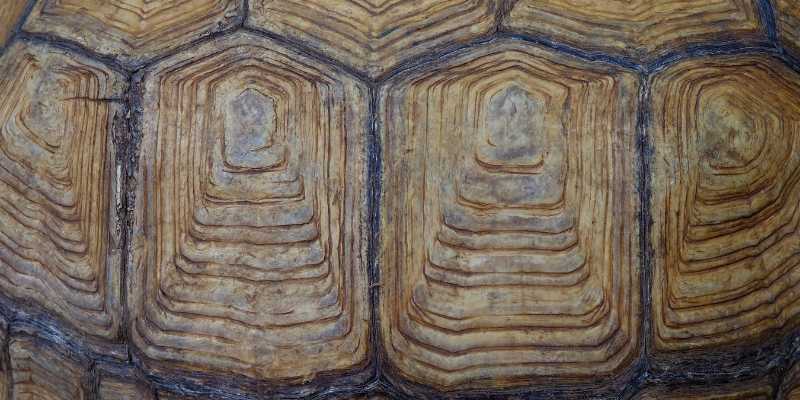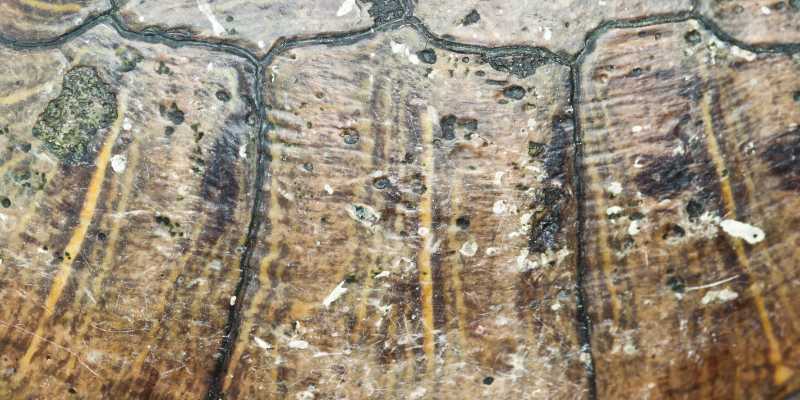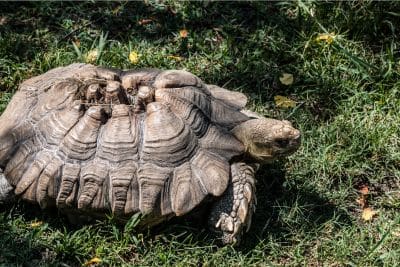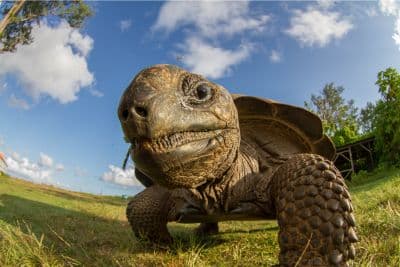Tortoise age can be difficult to estimate, but understanding growth patterns and physical markers helps you make a more accurate assessment.
Tortoises are famous for living long lives. For example, a Seychelles tortoise (Aldabrachelys gigantea hololissa) named Jonathan lived for an estimated 191 years, and there is no shortage of anecdotal accounts of other, much older, chelonians.
And this often means that age stays at the forefront of tortoise-lovers’ minds. It’s nearly impossible to see an obviously old guy or gal and not wonder if you’re looking at a tortoise that is older than you are – or maybe even older than your parents or grandparents.
But is it possible to look at a tortoise and determine its age? And if so, how do you tell how old a tortoise is? For the answer to these questions and further insight into tortoise size, maturity and growth rate, keep reading!
Shell Rings: A Clue to a Tortoise’s Age
Many nature-lovers know that trees from temperate areas produce annual growth rings. This happens because trees grow rapidly during the spring and summer, and then they grow quite slowly during the fall and winter.
So, by counting the rings present in an old tree stump or from a core sample collected by an arborist, you can tell how old the tree was with a fair degree of precision.
Many tortoise keepers believe the same phenomenon occurs in tortoises. But this isn’t true. While the shell scutes of tortoises do have visible rings (on both the plastron and carapace), they are not produced in an annual fashion.

These rings are formed when a tortoise grows rapidly. But this doesn’t always happen evenly over the course of their lifespan, nor on a cyclical basis, with a new ring appearing each year. These rings can be formed over varying time frames.
In fact, tortoises will often produce several rings in years in which food was plentiful. But they may produce few or no rings in difficult years, when they didn’t grow very much.
Additionally, tortoises who dwell in tropical forests don’t experience much variation in climate over the course of the year. Accordingly, there is no natural mechanism to cause the periodic growth bursts that occur in trees. Interestingly, the same can be said of tropical trees. They too don’t produce reliable growth rings either.
With all of this said, you can sometimes get a rough idea of a tortoise’s age by counting the rings on his shell. For example, if a tortoise has 45 rings, you can safely assume that he is not a 5-year-old animal, nor is he a 100-year-old specimen. He’s probably several decades old, but it’s tough to be more specific than that.
It’s also important to note that tortoise shells often darken or suffer wear and tear as they age. This can make it difficult to impossible to count rings anyway.
The Best Way to Determine Age
The only completely accurate way to determine a tortoise’s age is by knowing the year that the tortoise hatched. This is obviously not possible for most wild tortoises (save for those studied by wildlife biologists, who have been found shortly after hatching and are then marked and tracked for years at a time).
This is part of the reason it’s preferable to purchase captive-bred tortoises whenever possible. You’ll never know exactly how old a wild-caught tortoise is. But if you purchase a hatchling from a responsible breeder, you’ll be able to learn the year in which your pet hatched. Many breeders will even record hatch dates, allowing you to know your tortoise’s exact birth date.
Typically, breeders will group their available offspring for sale by year. In other words, they’ll sell all of their offspring from a given pairing that hatched in a given year for the same price.
Other Clues to Consider
While knowing your tortoise’s hatch date (or at least, the year in which he hatched) is the only way to know his age for certain, there are a few other things you can consider when trying to determine how long he’s been alive.
- Coloration: Tortoises often become darker with age. This won’t provide very specific information about your pet’s age, but you can reasonably conclude that tortoises who’re much darker than normal are often relatively old.
- Contrast: Many hatchling tortoises have bold, high-contrast patterns, which likely help them blend in with their surroundings. However, many species lose a lot of their contrasting shell patterns with age. It is important to note that this isn’t true of all species, though. For example, leopard tortoises (Stigmochelys pardalis) and pancake tortoises (Malacochersus tornieri) often retain significant markings throughout their lives.

- Scars: Tortoises – especially wild-caught tortoises – tend to get banged up over the course of their lives, as they battle predators and suffer minor injuries while burrowing or making their way across rugged terrain. Accordingly, tortoises with a number of scars are usually (but not always) older than those without an abundance of scars.
- Shell Texture: Tortoises shells often become worn down and smooth over time. This can even make it impossible to note the growth rings present on their shells. This takes a long time to happen, so generally speaking, tortoises with very smooth shells are older than those who have highly textured shells.
- Size: Although size most commonly relates to things like a tortoise’s health and food availability, it can also provide clues about a tortoise’s age. There are exceptions (especially when comparing tortoises of different sexes), but larger tortoises are generally older than smaller tortoises of the same species.
Researching Your Tortoise’s History
At times, it may also be possible to determine a tortoise’s approximate age via its provenance – essentially, the animal’s history as it moved through various keepers’ collections. This is not always easy, but by doing some homework, you may be able to find a lot of helpful information.
For example, you may have purchased a pet tortoise from another keeper two years ago. After speaking with the other keeper, you may find that he or she purchased the tortoise from a pet store as a hatchling five years earlier. This would indicate that your tortoise is about 7 years old, give or take a year.
This is exactly how some zoos and research institutions have determined the approximate age of extremely old tortoises, who may have passed through multiple hands. In some cases, famous tortoises will even appear in newspaper photographs, which can provide additional help in determining his age.
Of course, in the case of wild-caught tortoises, you’ll never be able to determine its hatch date with certainty. But you can at least learn its minimum age.
For example, if you traced your tortoise’s history back 10 years to a pet store who purchased him as a wild-caught juvenile, you’ll never know his exact age. But you do know that he’s at least 10 years old, and likely no more than about 15.
Age, Size, and Sexual Maturity
“Maturity” in tortoises is generally defined as being the age or size at which an individual is capable of reproduction. But the question is, what age or size do tortoises need to reach to qualify as “mature?”
Ultimately, this varies from species to species and individual to individual.
Some species (primarily small tortoise species) mature rather quickly and may be able to reproduce by 5 years of age. Other, larger species can take much longer to reach sexual maturity.
Male Sulcata tortoises can reach maturity between the ages of 8-15 years, whereas females are considered mature between 10-15 years of age. Desert tortoises (Gopherus agassizii) may not reach maturity until they reach 10 to 20 years of age. Aldabra tortoises (Aldabrachelys gigantea) can take even longer than this, with some individuals requiring 40 years to reach maturity.
But it’s important to note that tortoises are all individuals, who grow and mature at different rates. One individual of a species may reach maturity at 8 years of age, while another requires 12 or 16 or 20 years to do the same. Different populations of the same species can also exhibit differences.
For example, Desert tortoises from the Mojave Desert generally mature later than those from the Sonoran Desert. In the Mojave Desert, where conditions are harsher, with lower rainfall and sparse vegetation, it can take tortoises 14 to 20 years to reach sexual maturity.
This slower growth rate and delayed maturity are likely due to limited food resources and longer periods of inactivity during colder months.
In contrast, tortoises from the Sonoran Desert, which generally has more rainfall and a more diverse plant community, can mature more quickly. Sonoran Desert tortoises can reach sexual maturity in as little as 12 to 15 years.
This is likely due to a combination of individual variation, as well as the differences in environmental pressures experienced in different habitats. Food and water is typically more readily available in the Sonoran Desert, allowing the tortoises to grow more quickly, while predators may be more common in other habitats, which will reduce the rate at which the local tortoises can grow.
It’s not clear whether size or age plays a larger role in the maturation of tortoises, but size generally proves to be more important for other reptiles, such as snakes and lizards.
Changing Growth Rates with Age
Like many animals, tortoises grow at different rates over the course of their lives. They typically grow most quickly when they’re young, and their growth slows dramatically with size and age. Young tortoises may double their size in a matter of months, while older and larger individuals may take years to add another inch of straight-line shell length.
Individual variation, food availability, species specific weight range, and environmental conditions all play a role in a tortoise’s growth rate, but the majority of individuals do exhibit this tendency.
Are You Starving Your Tortoise?
Save 10% on premium tortoise food and supplements from Tortoise Resource Center on Amazon now using code BUYNOWGET10

Sulcata Vitamin & Mineral Topper Supplement
30-Day Supply | 2 oz (56 g)
$24.99

Baby Sulcata Tortoise Superfood Powder
30-Day Supply | 2.5 oz (70.8 g) Bag
$24.99
Growth in Senior Years
Some animals exhibit something called determinate growth, meaning that they stop growing around the time they reach sexual maturity. Other animals are said to exhibit indeterminate growth, in which they continue to grow after reaching sexual maturity. Such animals may grow for the rest of their lives, provided that they have sufficient access to food.
Most birds and mammals exhibit the former type of growth; once a dog becomes sexually mature, it generally stops growing (though it may gain weight in the form of excess body fat).
By contrast, many reptiles and fish are said to exhibit the latter type of growth. A large python, for example, may be capable of reproducing at only 6 feet in length, but it will continue to grow and eventually reach 12 feet in length by the time it dies.
Interestingly, scientists haven’t yet determined which growth pattern tortoises exhibit. In actuality, it likely varies from one species to the next.
However, at least one study has found that desert tortoises are capable of growing after they reach sexual maturity. This would tend to support the notion that they exhibit indeterminate growth. But the researchers also found that most desert tortoises do stop growing at advanced ages.
Much more research is needed to determine if this is the same pattern all tortoises exhibit.
Citations
- Animal Diversity Web – Testudo hermanni
- Journal of Arid Environments – Longevity and Growth Strategies of the Desert Tortoise (Gopherus agassizii) in two American deserts
- Smithsonian — Five fun turtle and tortoise facts from the Smithsonian’s National Zoo
- Copeia – Indeterminate Growth in Desert Tortoises


